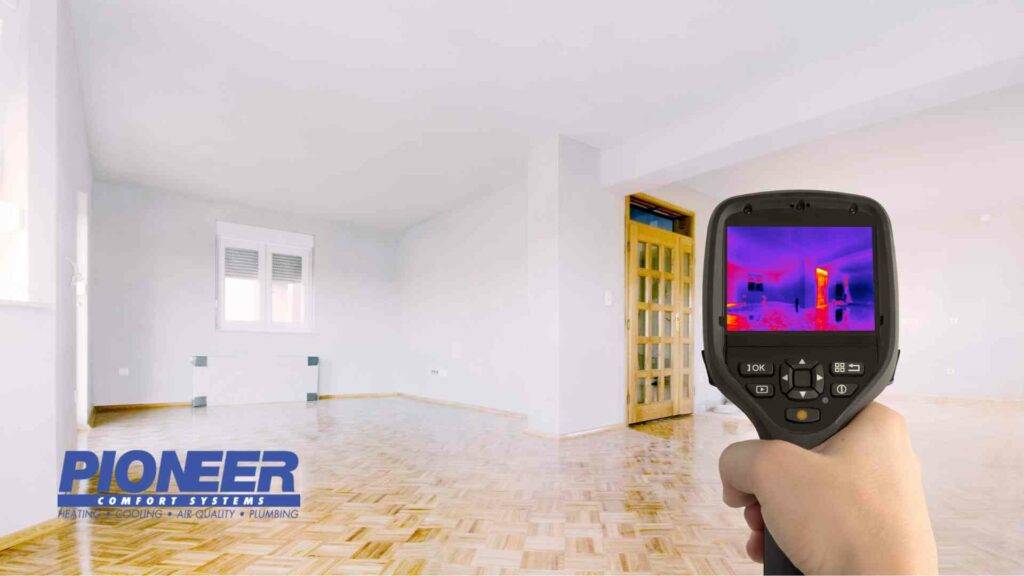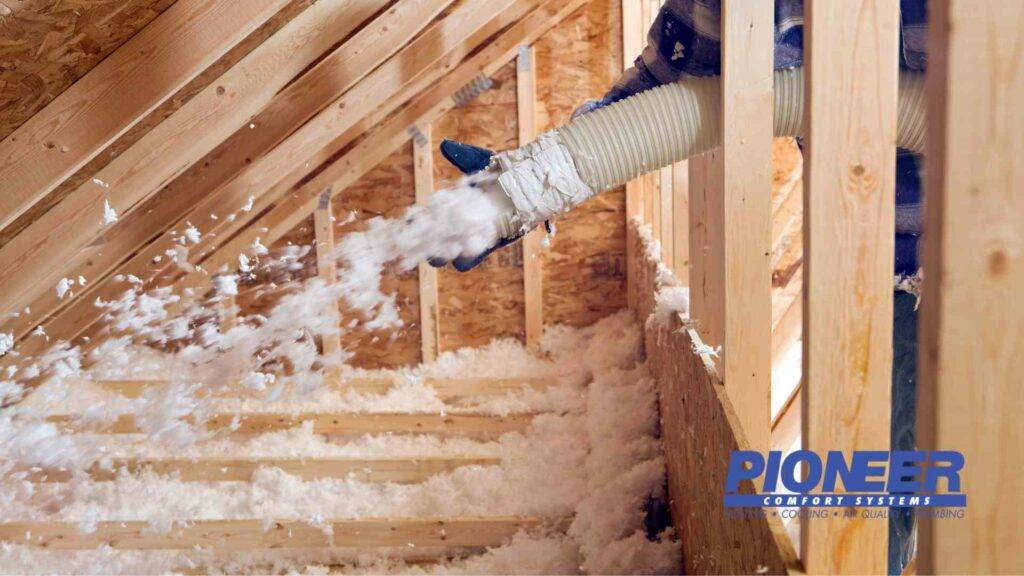A great way to improve your home’s energy efficiency is with upgrades and regular preventive maintenance for your heating and cooling systems. These systems account for most of your home’s energy use.
However, to truly maximize your home’s energy efficiency, you need to consider your entire home as a system. It doesn’t matter how energy efficient your furnace is if insulation gaps allow cold air to pour into your home during the winter.
How Energy-Efficient Insulation Works to Reduce Heating and Cooling Costs
When two adjacent spaces have different temperatures, heat moves from the warmer space to the colder space until they reach the same temperature. This is why your home’s heat leaks out during the winter, and in the summer heat leaks in.
It’s also why your cooling or heating system has to work hardest on the coldest or hottest days. The bigger temperature difference between the unheated spaces and heated spaces causes the heat to try to close the gap faster.
Insulation works to block this transfer. It traps heat either inside or outside your home. When you have poor insulation or gaps in your insulation work, it’s almost like your home has no walls at all or you’ve left your doors and windows wide open.
Many homes have just a few inches in the wall cavity areas and attic. By better insulating your attic, walls, floors, and any crawl spaces or basements, you can slow the thermal bridges and cut how much you use your heating or cooling system to maintain a comfortable temperature and lower utility bills.

Benefits of Energy-Efficient Insulation
Energy-efficient insulation works by trapping air molecules. This can help to reduce heating and cooling costs, improve home comfort, and make your home more sustainable.
Reduced Heating and Cooling Costs
Homeowners can save an average of 15% on utilities by adding insulation. More specifically, attic insulation, foundation insulation, and insulation to floor joists, exterior walls, and basement rim joists.
The amount of insulation materials you need will vary depending on the climate you live in, the type of home insulation material you choose, and the age and construction of your home. However, even a small amount of insulation can make a big difference in your energy savings.
Increased Home Value
Adding insulation can increase home value by making your home more energy-efficient. Homes with energy efficiency are more desirable to buyers, as consumers understand that when you save energy, you save more money down the road.
According to a study by the National Association of Realtors, homes that are properly insulated for energy efficiency sell for an average of 10% more than homes without these features.
Adding insulation is a great way to increase your home’s value. It is a relatively inexpensive investment that can pay off big in the long run.
Reduced Noise Pollution
Home insulation helps reduce noise pollution by absorbing sound waves. Sound waves are vibrations that travel through the air, and proper insulation can help to slow down and absorb these vibrations. This can help to reduce the amount of noise that is transmitted through your home.
If you live near a busy road, adding insulation to your walls and attic can help to reduce the amount of traffic noise that you hear inside your home.
The amount of noise reduction that you get will depend on how much insulation is used and the insulation material choice, along with its R-value and thermal resistance. However, even adding wall insulation with a smaller R-value can make a big difference.
If you are concerned about noise pollution in your home, adding insulation is a great way to reduce it.
Improved Air Quality and Reduced Air Leaks
Home insulation helps improve air quality by reducing air leakage. Air leaks are gaps and cracks in your home’s wall cavities, interior ceilings, and floor joists that allow air leakage. This can bring in pollutants from outside, such as dust, pollen, and exhaust fumes.
Home and attic insulation can help to contain air leakage and keep the air inside your home cleaner. Sealing air leaks can help to improve your health and reduce the risk of allergies and asthma.
The amount of air quality improvement that you get will depend on the type of insulation you use, its R-value, and how well it is installed. However, adding insulation in any capacity can make a big difference.
Improved Sustainability
Finally, energy-efficient insulation can make your home more sustainable. By reducing your reliance on a cooling or heating system, you can help to reduce your carbon footprint and contribute to a healthier environment.
How to Choose the Right Energy-Efficient Insulation for Your Home
The right insulation for your home will depend on the climate you live in, the type of construction your home has, and your budget.
Here are some factors to consider when choosing insulation:
- Climate: If you live in a cold climate, you will need insulation that is designed to keep your home warm in the winter. If you live in a warm climate, you will need insulation that is designed to keep your home cool in the summer.
- Construction: The type of construction your home has will also affect the type of insulation you need. For example, if your home has wood-framed walls, you must select different insulation types than if your home has concrete walls.
- Budget: Insulation can vary in price, so it is important to set a budget before you start shopping.
If you are unsure about which types of insulation are contenders for your home, it is a good idea to consult with a qualified contractor.
Types of Insulation Materials
Fiberglass Insulation: Fiberglass insulation is a popular type of energy-efficient insulation that is made from tiny glass fibers. It is relatively inexpensive and easy to install, and it can help to reduce the cost of cooling and heating by up to 50%.
Foam Insulation: Foam insulation is a type of insulation that is made from a variety of materials, including polyurethane, polyisocyanurate, and extruded polystyrene.
This type of insulation is divided into two categories: spray foam insulation and blown-in insulation. It is normally used for home or attic insulation and has a number of advantages, including:
- It is a good insulator, which can help to save energy and reduce costs.
- It can help to seal air leaks, which can also help to save energy.
- Easy to install.
- Available in various thicknesses; choose from high R-value or lower R-value.
Cellulose Insulation: Cellulose insulation is made from recycled paper. It is also divided into two categories: blown-in insulation and batt insulation. This insulation material is often used for attic insulation, wall insulation, and insulation for floor joists.
Cellulose insulation is available in two main types: blown-in and loose-fill insulation. Loose-fill is installed by blowing it into place with a special machine. Blown-in cellulose insulation is installed by blowing it into place through a hose.
How to Install Energy-Efficient Insulation
The installation of energy-efficient insulation should be done by a qualified contractor. The contractor should follow the manufacturer’s instructions carefully. Regardless of whether the insulation is blown in or loose fill, it should be installed in all areas of your home where heat loss or gain is a concern.

Improving Home Performance With Insulation
Home Performance is an ENERGY STAR program that looks at how all of your home’s systems work together to affect your energy use. Upgraded insulation is one of the most common recommendations for improving energy efficiency.
Here are the most common energy-saving insulation improvements:
- Attics: Many attics have light or no insulation, both to lower building costs and to provide storage space. Unused areas can be cheaply filled with additional insulation to keep heat from rising out of your home.
- Walls: Spray foam insulation can be poured into the wall cavities of exterior walls with minimal wall insulation to improve energy efficiency with minimal disturbance to the rest of your home.
- Air Ducts: Heat transfer also occurs between the air flowing through your air ducts and the surrounding uncooled or unheated air in your attics or walls.
- Non-living spaces: Areas without heating or cooling, such as garages, basements, and crawl spaces, create pockets of air that are hotter or colder than the rest of your home. More insulation should be added around these areas, especially if you have an under-insulated home.
Cost of Energy Efficient Insulation
The cost of energy-efficient insulation varies depending on the types of insulation, the R-value of the insulation upgrades, the size of your home, and the labor costs in your area. However, the cost of energy-efficient insulation is typically offset by the savings you will realize on your heating and cooling bills.
The Return on Investment
The return on investment (ROI) for energy-efficient insulation can vary depending on the types of insulation, the size of your home, and the cost of energy in your area. However, in general, energy-efficient insulation can have a positive ROI of 5-10 years.
Energy-Efficient Insulation Rebates and Incentives
There are a number of government and utility rebates and incentives available for energy-efficient insulation. You can find out more about these rebates and incentives by contacting your local utility company or government agency.
Professional Installation for Insulation in Shreveport
Pioneer Comfort is your one-stop shop for all insulation work in Shreveport. We offer a wide range of heating and air conditioning services, including attic insulation, wall insulation, and floor insulation. We also offer air sealing services to help you reduce radiant heat gain and AC leaks, improving your home’s energy efficiency.
If you’re looking for a reliable and experienced insulation contractor in Shreveport, then call Pioneer Comfort today. We’ll help you save money, improve your comfort, and reduce your environmental impact. We proudly serve Shreveport, Bossier, Natchitoches, and surrounding communities.

